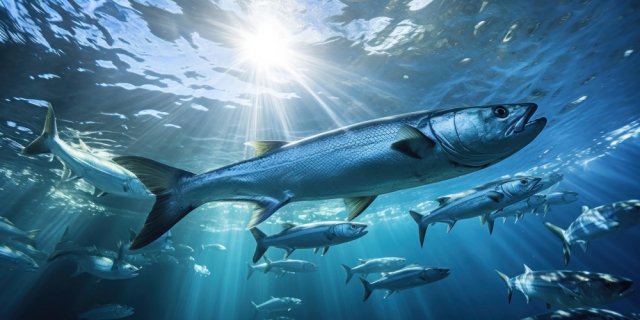If you’re looking to master the deep blue sea and land a bluefin tuna, you’re in for an interesting yet exciting challenge. Because of their formidable strength and speed, these fish are highly valued among anglers. With these tips from the pros, you will be able to become a master of catching bluefin Tuna in no time at all. Let’s dive in!
Perfect Your Knot Tying Skills
It is important to have strong knots if you want to catch bluefin tuna. These fish put up a fierce resistance and when a knot is weak, it leads to missing fishes that should have been caught. The FG knot or Palomar knot is recommended because of its strength and dependability. A tight grip on the line with a firm knot will make all the difference between an impressive victory and a disheartening escape.
Choose the Right Gear
Having the right gear is essential as these fish are very large and require strong equipment for successful catching. Start with heavy-duty rod and reel combinations that can handle the immense power and endurance of bluefins. A 50-80 pound rated rod affords sufficient backbone for prolonged battles against this species of tuna whereas a reel should be able to carry more than enough line for it isn’t going to break out while running long distances along its strike zone. For quality fishing tools and gear to aid you in your pursuit, check out the selection available at meltontackle.com.
Bonus Point: It’s not all about catching fish; investing in quality gear also means being ready for the rigors of tuna fishing. The high-quality rods, reels, and lines are well-made to take the immense tension and strain caused by Bluefin Tuna. With such reliability, fewer equipment malfunctions will occur hence you can concentrate on having fun by enjoying the catch rather than anxiously watching out for equipment failures. In the bluefin tuna fishing world, having the right gear could mean getting a lifelong miss or catch.
Master the Art of Trolling
Trolling is very effective and is actively used to catch bluefin tuna. This method entails applying several lure or shad-like baitfish that imitate the appearance and shape of their favorite prey. Ideally, depending on the conditions of the water, you should troll at a boat speed, which ranges from 5-8 knots.
Super Tip: Check your sonar thoroughly for schools of tuna or baitfish that signal the presence of Bluefin most of the time. Trolling speed and depth should be changed depending on what the sonar has noted down. Ideally, vigilance and the ability to wait should be added to the basic set of skills necessary for a troll. Trolling may require some time spent practicing the tactic, but the payoff is beyond words when a great bluefin tuna is caught.
Utilize Chumming to Attract Tuna
Chumming is an effective way to attract bluefin tuna to your boat or wherever you have chosen to fish. Bait this up using a combination of fish and fish oil from scratch. This may be done at a slow pace so that the chum is dropped over the water in a straight stream. This technique can make tuna come up from the depths and remain around your boat. Spend some time with your chumming to ensure that the fish are still trapped with you so that you can increase your chances of landing one.
Opt for Live Bait When Possible
The Live bait fishing technique is incredibly effective, especially for catching the Bluefin tuna fish. Oil fish, Scomber, and krill are valuable fish, most commonly known as mackerel, sardines, and herring respectively. Leaving them in the water to float or using the kite to drop them on the water's surface may trigger a bite. Bluefin Tuna are aggressive fighters and they are visual predators, therefore a lively bait will make a prompt strike.
Pay Attention to Water Temperature
Bluefin tuna are very picky when it comes to choosing the water temperature of their habitat. They like warm waters that are between 15 and 21 ° C most of the time. It is also advisable to use the same temperature gauge to look for those sections of water with the best temperature range. These zones typically contain baitfish on which Bluefin Tuna feeds, hence the need to identify them accordingly.
Understand Tuna Behavior
Knowledge of the behavior of bluefin tuna can not only add to your success greatly. Tuna, for example, are migratory creatures whose movements are attributed to the abundance of food and water temperatures. They prefer being most active at the break of dawn and in the evening. Pay special attention to their feeding habits and movement patterns throughout the year to optimize your fishing expeditions. The more you understand them the more it becomes easier for you to forecast where they are most likely to be found or what they are most likely to do.
Use Topwater Lures for Exciting Action
Topwater lures are another exciting style of fishing and are also successful for Bluefin Tuna. Poppers and stick baits are large-profile lures that mimic injured baitfish on the surface, provoking powerful assaults. Slip your spoon beneath the boat and give it a twitching, zig-zag retrieve to mimic escaping food. Expect them to engage you with staple surface strikes that Bluefin is famous for. This type of fishing is not only effective but introduces an adrenaline rush in the whole fishing process.
Stay Patient and Persistent
Three essential values are central in bluefin tuna fishing and they include patience, perseverance, and consistency. These fish are not easy to find and it may take some time before one is caught or even hooked. Just stay alert and have multiple tries with different techniques until the right one is identified. Do not be discouraged when you go for several hours without catching any fish; Bluefin fishing usually requires long intervals between moments of high activity. The efforts will not go unrewarded when one day you land the big fish.
Conclusion
Learning to fish for the renowned bluefin tuna is a long process that is both gratifying and complicated. With the help of these 9 effective fishing methods, anyone can effectively target these powerful fish. As always, the specifics are the essence – practice your knots to the core, make sure to dress appropriately for the trip, and be aware of how tunas behave. Alas, wait for the right moment, fish in ways that do not harm the environment and you will be successful with fishing on the high sea. Happy fishing!






